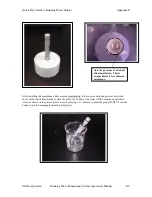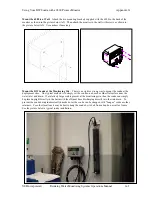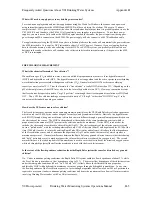
Frequently Asked Questions About YSI Drinking Water Systems
Appendix H
YSI Incorporated Drinking Water Monitoring Systems Operations Manual
H-5
What will I need to supply power to my drinking water sondes?
For stand-alone deployments and real-time applications using EcoWatch for Windows, the sondes can be powered
using internal batteries where the 6920DW and 600DW-B will have a battery life of about 30 days at a 15 minute
sample interval. If AC power is present at the site of the stand-alone deployment, then it is probably prudent to use the
YSI 6038 (US and Canada) or the YSI 6651 (all countries) power supplies to provide power. To use these power
supplies, you must have a field cable with a 6095B adapter attached to the sonde; the power input from the supplies
goes through an MS-4 connector on the 6095B. The power supply will also connect to a 6067B calibration cable.
For applications involving the YSI 6500 or any data collection platforms, the sonde will automatically be powered from
the 6500 (attached to AC power) or DCP (attached to either AC or DC power). However, if you are logging back-up
data to the sonde memory while also collecting it via the DCP or a SCADA system, you probably will want to have
batteries in the sonde so that data will continue to be collected and stored in internal memory if the power to the 6500
or DCP is interrupted.
FREE CHLORINE MEASUREMENT
What is the chemical formula of “free chlorine”?
When chlorine gas (Cl
2
) is added to water, a reaction (called disproportionation) occurs to form hypochlorous acid
(HOCl) and hydrochloric acid (HCl). The hypochlorous acid is a strong oxidant and the active species in most drinking
water disinfection processes rather than gaseous chlorine (Cl
2
). One molecule of HOCl has the same oxidizing
capacity as a molecule of Cl
2
.
Thus, the formula for “free chlorine” is really HOCl rather than Cl
2
. (Depending on the
pH of the sample some of the HOCl may also be in the form of hypochlorite ion OCl
-
). However, convention dictates
that free chorine be reported in units of “mg Cl
2
per liter” even though the active compounds in solution are HOCl and
OCl
-
. Thus, YSI free chlorine readings are expressed in units of “Cl2 mg/L” rather than “HOCl/OCl
-
mg/L” to be
consistent with standard reporting convention.
How does the YSI sensor measure free chlorine?
The free chlorine sensor operates on the same amperometric principles as the YSI Rapid Pulse dissolved oxygen sensor
which is used in all YSI 6-series sondes designed for surface- and ground-water studies. Basically, the hypochlorous
acid (HOCl) formed when gaseous chlorine is dissolved in water diffuses through a permeable membrane which covers
the electrodes of the sensor. The HOCl is then reduced at the cathode of the sensor producing a current which is
proportional to the amount of HOCl present in the solution outside the membrane. As the HOCl is reduced at the
cathode, the silver anode is oxidized to silver chloride (AgCl). The electrochemistry of the chlorine sensor is carried
out in a “pulsed mode”, with the cathode polarized for only 1/100 of the time (40 mS) and depolarized for 99/100 of the
time (3960 mS) in order to (a) use the existing Rapid Pulse DO circuitry and software, (b) reduce the flow dependence
of the free chlorine sensor, and (c) minimize the deposition of AgCl on the anode, the removal of which requires a
maintenance protocol. One major difference between the Rapid Pulse oxygen and chlorine sensors is that the reducing
and “hold” potentials are set to much more positive values where chlorine is reduced, but oxygen is not. The second
major difference is that a hydrophobic Teflon membrane is used to cover the electrodes of the dissolved oxygen sensor
while a hydrophilic polyvinylidene fluoride membrane is used with the free chlorine sensor.
Is the extent of the flow dependence reduction from the Rapid Pulse system the same for dissolved oxygen and
chlorine?
No. Under continuous pulsing conditions, the Rapid Pulse DO system exhibits a flow dependence of about 3 % while
the Free Chlorine system shows a flow dependence of up to 25 %. The greater flow dependence of the chlorine system
under the same pulse conditions (40 mS “on”/3960 mS “off”) is likely due to the different diffusion properties
exhibited by HOCl with a hydrophilic membrane versus oxygen gas through a hydrophobic membrane. In any case,
the flow dependence of the free chlorine sensor is of great enough magnitude that a flow of about 500 mL per minute is
required to overcome it under continuous pulsing conditions and hence the requirement for a flow cell for most studies
involving Drinking Water sondes with Free Chlorine sensors.
Содержание 600DW-B
Страница 3: ......
Страница 239: ...Principles of Operation Section 5 YSI Incorporated Drinking Water Monitoring Systems Operation Manual 5 26...
Страница 251: ...Warranty and Service Information Section 8 YSI Incorporated Drinking Water Monitoring Systems Operations Manual 8 4...
Страница 259: ...Required Notice Appendix B YSI Incorporated Drinking Water Monitoring Systems Operations Manual B 2...
Страница 264: ...EMC Performance Appendix D YSI Incorporated Drinking Water Monitoring Systems Operations Manual D 2...
Страница 268: ...Specifications Appendix E YSI Incorporated Drinking Water Monitoring Systems Operations Manual E 4...
Страница 297: ......








































